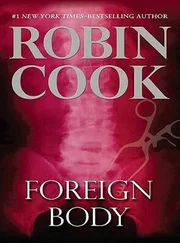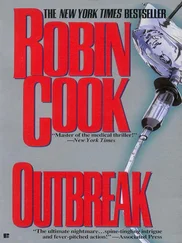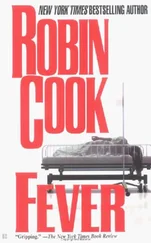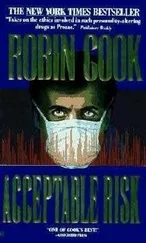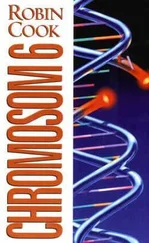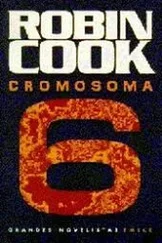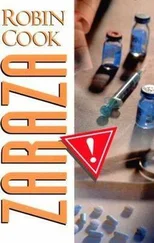At the base of the stairs, Stephanie skidded to a stop. She found herself in a short, dimly lit corridor with access to the freight elevator along one wall and a shiny, stainless-steel door totally devoid of hardware at its end. There was no door handle or even lock. Stephanie approached the door and put her hand on it to push. It was warm to the touch but entirely immobile. She put her ear to it. She thought she could detect a slight whirring noise from beyond.
Stephanie leaned back and glanced around the blank door’s periphery. It sealed against a metal jamb with a machinist’s precision. Getting down on her hands and knees, she noted it was the same at the door’s base. The care with which the door was fashioned fanned her already considerable curiosity. She got back on her feet, and with the side of her fist, she thumped quietly against the door. She was trying to gauge its thickness, which she surmised was considerable, since it was rock-solid.
“Well, so much for my mini-investigation,” Stephanie whispered out loud. She shook her head in frustration while allowing her eyes to trace around the periphery once more. She was surprised there was no bell or intercom system, nor any obvious way to open the door or communicate with anyone within.
With a final sigh of exasperation accompanied by an expression of disgust, she turned back to the stairs, recognizing she’d have to conjure up another strategy if she intended to continue her clandestine sleuthing. But she only took a single step when her eye caught something she’d missed. Barely protruding from the wall opposite the freight elevator and quite inconspicuous in the dim light was a tiny, three-inch-long by three-quarters-of-an-inch-wide card swipe. Stephanie had not seen it earlier, because her attention had been overwhelmed by the gleaming door itself. Also, the swipe was the same neutral color as the wall and was more than six feet from the door.
Megan Finnigan had made sure Stephanie and Daniel had Wingate Clinic identification cards. Each had an ugly, mugshot-style Polaroid photo laminated on the face with magnetic strip on the back. Megan had said that the cards would be more important for security purposes when the clinic was up to strength personnel-wise, at which time they would be coded for the bearer’s individual needs. In the meantime, Megan told them the cards were necessary to get into the lab’s storeroom for basic supplies.
On the odd chance the ID card might work for the egg room at this early stage of the clinic’s existence, Stephanie gave it a try. She was immediately rewarded by the stainless-steel door retracting to the side with a muffled whoosh of compressed air. At the same time, Stephanie noticed that she was enveloped by a weird glow emanating from the room beyond, which she guessed was a mixture of incandescent and ultraviolet light. There was also an accompanying waft of moist, warm air, and the whirring noise she’d thought she’d heard earlier with her ear to the door was now a definite presence.
Pleased at this sudden but welcome reversal of fortune, Stephanie quickly stepped over the threshold and found herself in what appeared to be a giant incubator. With the temperature in the vicinity of 98.6 degrees Fahrenheit, or body temperature, and the humidity close to one hundred percent, she felt perspiration break out all over her body. Although she was wearing a sleeveless blouse, she had a short, white laboratory coat over it. She now understood why Cindy wore a special lightweight cotton jumpsuit.
Racks similar to bookshelves but containing tissue culture dishes formed a gridlike floor plan similar to the stacks of a library. Each was about ten feet long, constructed of aluminum with adjustable shelves and extended from the tile floor to the rather low tile ceiling. All the tissue culture dishes in Stephanie’s immediate view were empty. Ahead of her was a lengthy aisle, the shelving of which made it appear to be a study in perspective. It was so long that a dim, humid haze obscured its distant end. From the size of the facility, it was obvious the Wingate was preparing for significant production capacity.
Stephanie started forward at a rapid walk, glancing from side to side. Thirty paces into the room, she stopped when she found a rack that contained actively growing tissue cultures, as evidenced by fluid levels visible through the clear glass containers. She lifted one out. Written in grease pencil on its cover was OOGONIA CULTURE, accompanied by a recent date and an alphanumeric code.
Stephanie replaced the dish and checked others throughout the rack. They had different dates and different codes. Learning that the Wingate was seemingly successfully culturing primitive germ cells was both interesting and disturbing for a variety of reasons, but it was not her goal. What she was hoping to do was to ascertain the origin of the oogonia and the oocytes they were culturing and maturing. She thought she knew, but she wanted definitive proof that she could pass on to a Bahamian authority after Butler’s treatment and after she, Daniel, and Butler had returned to the mainland. She glanced at her watch. Eight minutes had now gone by, which was about half her allotted time.
With mounting anxiety, Stephanie pressed ahead, quickening her pace while peering down the side corridors as well as cursorily glancing at each rack of shelves she passed. The problem was that she didn’t know what she was looking for, and the room was enormous. To make matters worse, she began to notice a mild sensation of air hunger. It then dawned on her that the atmosphere in the egg room probably had an elevated level of carbon dioxide for the benefit of the tissue cultures.
After another twenty paces Stephanie stopped again. She’d come to a rack with unique and apparently customized tissue culture dishes. Stephanie had never seen anything like them. Not only were they larger and deeper than usual, but they also had a built-in internal matrix on which the cultured cells could grow. In addition, they were set on motorized bases to keep them in continuous, horizontal, circular motion, presumably to circulate the culture medium. Wasting no time Stephanie reached in and lifted out one of the dishes. On its cover was written MINCED FETAL OVARY, TWENTY-ONE WEEKS GESTATION; OOCYTES ARRESTED IN DIPLOTENE STAGE OF PROPHASE, followed again by a date and a code. Stephanie checked the other dishes in the rack. As with the oogonia cultures they all had different dates and different codes.
The next few racks were even more interesting. They housed tissue culture dishes, which were larger and deeper still, but there were fewer per shelf. Most of them were empty. Those that weren’t contained a fluid growth medium that was being circulated by a complex of tubes to central machines, which appeared like a miniature kidney dialysis unit and which collectively made the background whirring noise that filled the room. Stephanie bent over and peered into one of the culture dishes. Submerged in the contained fluid was a small, ovoid, and ragged piece of tissue, approximately the size and shape of a manila clam. Vessels that protruded from the tiny organ were cannulated by minute plastic tubes leading to another, even smaller machine. The tiny organ was being internally perfused as well as being submerged in continuously circulated culture medium.
Stephanie stuck her head into the rack so she could look at the top of the container without disturbing it. Written in red grease pencil was FETAL OVARY, TWENTY WEEKS GESTATION along with a date and code. Despite the implications, she couldn’t help but be impressed. It seemed that Saunders and his team were keeping intact fetal ovaries alive at least for a few days.
Stephanie straightened back up. Although hardly definitive proof, what she was finding in the egg room was certainly consistent with her suspicions that Paul Saunders et al. were paying young Bahamian women to be impregnated and then aborted at about twenty weeks to harvest fetal ovaries. With her embryology training, she knew something most laypeople didn’t know, namely that the diminutive ovary of a twenty-one-week-old fetus contains about seven million germ cells capable of becoming mature oocytes. Most of these eggs are destined to disappear inexplicably prior to birth and during childhood, such that when a young woman begins her reproductive years, her germ cell population has been reduced to approximately three hundred thousand. If obtaining human oocytes is the goal, the fetal ovary is the mother lode. Unfortunately, Paul Saunders seemed to know this as well.
Читать дальше

